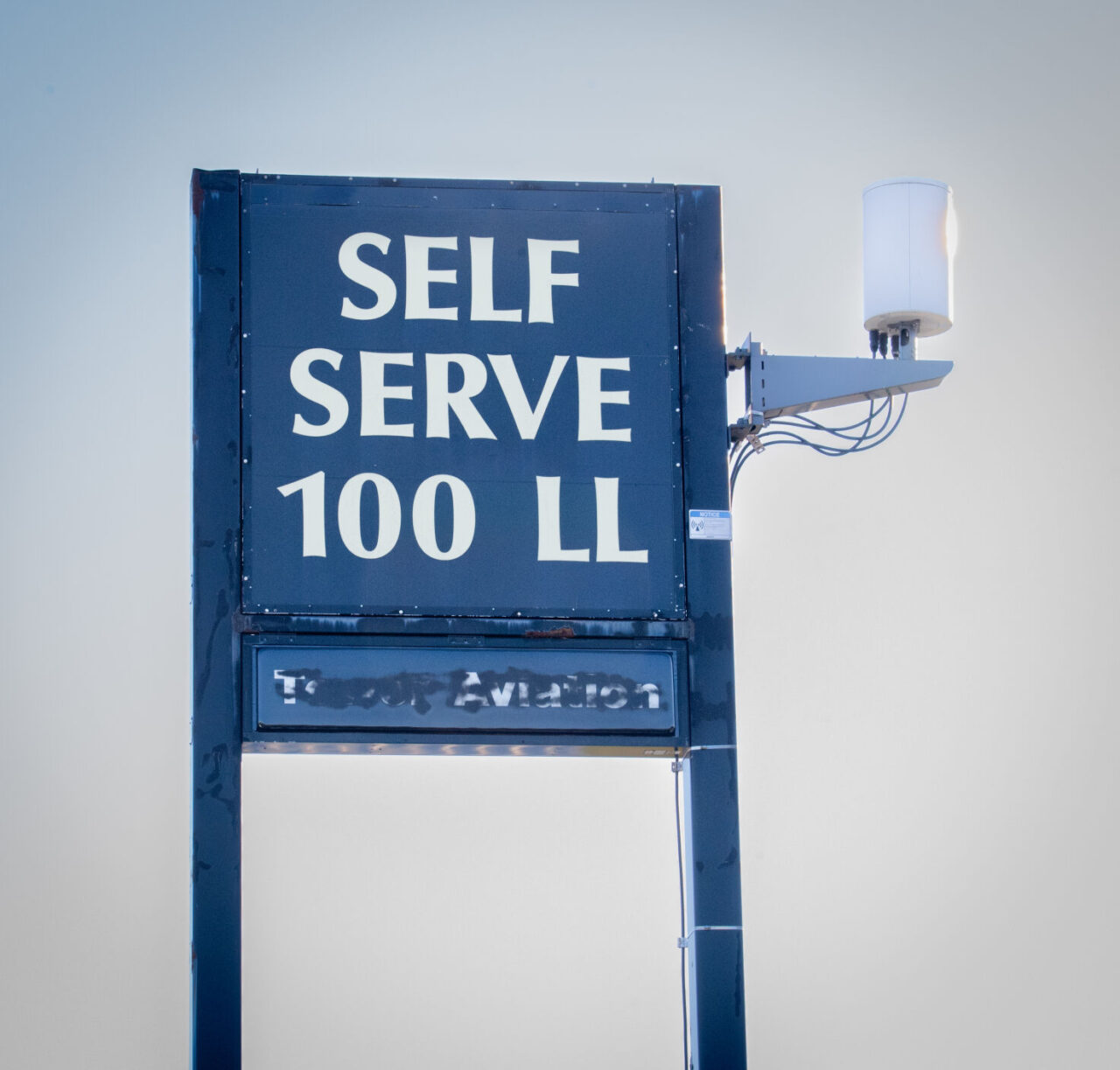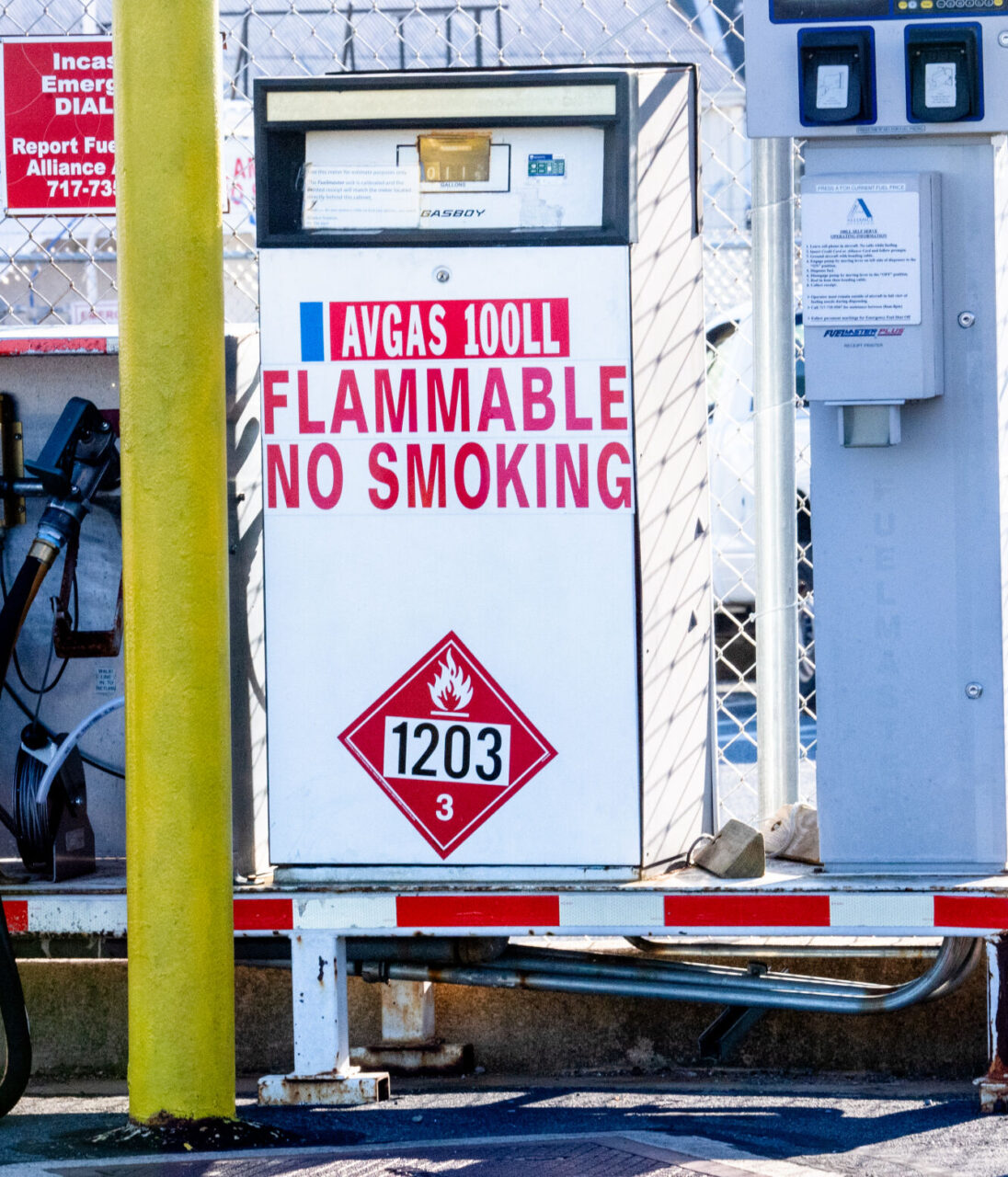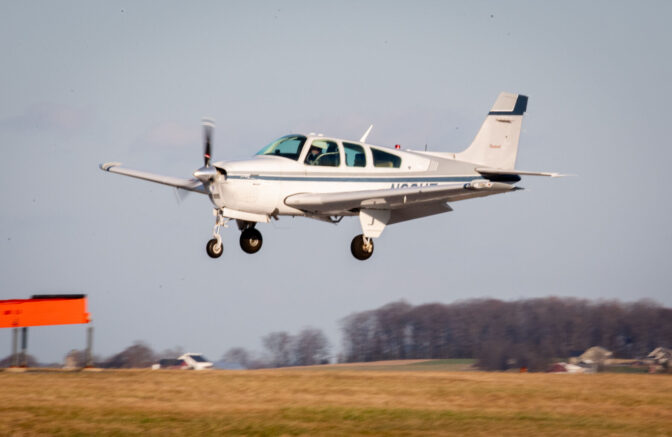
Small airplanes are parked in a line at Lancaster Airport Thursday, Jan. 11, 2023.
Blaine Shahan / LNP | LancasterOnline

Small airplanes are parked in a line at Lancaster Airport Thursday, Jan. 11, 2023.
Blaine Shahan / LNP | LancasterOnline

Blaine Shahan / LNP | LancasterOnline
Small airplanes are parked in a line at Lancaster Airport Thursday, Jan. 11, 2023.
Over a 30-minute period one January afternoon, two small airplanes passed over Lindsay Hafer’s home on Kingsbridge Drive in Manheim Township.
The mother of two children, ages 5 and 10, said she had never thought about the possible health hazards of living near an airport until she moved in June to her current home, which sits under the flight path for Lancaster Airport.

Blaine Shahan / LNP | LancasterOnline
Lindsay Hafer, a resident of Manheim Township near Lancaster Airport, comments about airplanes using leaded fuel outside her home Thursday, Jan. 11, 2023.
“It’s definitely been something I think about now,” she said, pointing at an airplane that had just flown by.
Ask someone to describe the health risks of living near an airport and they might cite plane crashes or fuel explosions. But in fact, one of the biggest potential threats from living by an airport comes from the exhaust of planes burning gas that still contains lead.
Lead poisoning has been linked to long-term cognitive impairments and behavioral issues such as aggression and hyperactivity. Even low levels of lead in a child’s blood have been shown to negatively affect intelligence, ability to pay attention and academic achievement, according to the Centers for Disease Control and Prevention. Any amount of lead exposure can harm cognition in children, according to the Environmental Protection Agency.
Planes with piston engines are the largest source of lead emissions in the country, contributing about 70% of the lead entering the air annually, the EPA reported last year.
In the last year, 77% of the air traffic in and out of the Lancaster Airport in Lititz was propeller-driven planes powered by leaded gas, said Austin Beiler, director operations and development for Lancaster Airport. That percentage translates to 83,670 operations — takeoffs or landings — at the airport; jet aircraft that use unleaded fuel account for the other 23%.
Shayla Powell, a spokesperson for the EPA, said the agency is unaware of any testing for lead specifically around Lancaster Airport. State and local air-quality agencies are required to monitor the air near airports with estimated emissions of 1 ton or more per year, a threshold Lancaster Airport has not crossed, she said.


But two EPA studies conducted elsewhere and published in the last four years found elevated levels of lead in individuals living up to 500 meters, or one-third of a mile, from an airport over a three-month study period. The agency estimates 5 million Americans reside within that distance of an airport serving piston-engine aircraft. With regard to Lancaster Airport, nearby areas are largely commercial and agricultural, with the closest homes about one-fifth of a mile from the runways.
While an EPA spokesperson said the studies were not human risk assessments and cannot be used to determine whether it is safe to live near an airport, public health experts say the findings are concerning.
“No amounts of lead are considered to be safe, therefore children living in close proximity to airports would certainly have a higher risk from the health effects of increased lead exposure,” said Paul Hill, environmental health and safety director at Millersville University.
Hill’s Millersville colleague, Jeremiah Mbindyo, a professor in the chemistry department, echoed that view: “If there is exposure (to lead), then there’s a concern.”
Lead became an additive to gasoline in the 1920s, allowing gas to burn more smoothly and improving engine performance.
The EPA started phasing out leaded gasoline in cars in 1973, although it wasn’t fully banned in the U.S. until 1996. Aviation gasoline is now the only transportation fuel in the United States that contains lead.
Thanks to the transition away from leaded gas in cars, the most common source of lead poisoning today is paint used in housing built prior to 1978, Hill said.
Lead paint is a well-known threat and the focus of long-standing remediation campaigns. For example, in 2019, Lancaster city received $9.1 million in federal funds to eliminate lead hazards in homes and rental properties.
But is living near an airport really as risky as living in a house with lead paint? It depends on the amount of piston engine activity at an airport, Hill said. That activity includes idling, taxiing, pre-flight engine run-ups, and takeoffs and landings, all of which affect the concentration of lead that is being emitted, Hill said.
Ed Foster, executive director of Lancaster Airport, said lead levels around the airport are a concern, but not a serious one.
Foster said airport staff use protective gear, such as masks and gloves, when fueling the airplanes. As for vapors emitted in the air; that is not something they can control, he said.
“Leaded fuel has been around for decades, and we are at the mercy of the federal government, specifically the FAA, to come up with a solution,” Foster said. “We can only provide what we have.”
The main lead-containing additive in aviation gas is tetraethyl lead, which can be inhaled as a vapor. When leaded gas burns, it also can form lead oxide particles that can settle on the surface or be inhaled, Mbindyo said.
Lead particles are heavy and settle; they can then be absorbed by plants and soil. People who eat food from contaminated gardens could see levels of lead in their blood grow, Hill said.
Anyone concerned about lead concentrations in soil can send samples to a laboratory for testing. Many state university agriculture departments offer soil testing, but at a cost, including Penn State. For more information on Penn State’s program, visit lanc.news/LeadTest.
Crop land directly abuts all four sides of Lancaster Airport.
Children also are closer to the ground and have a tendency to put objects into their mouths, making them more susceptible to ingesting lead from contaminated items on the ground or in a yard, he said.
“Be certain that you are washing your hands, washing your vegetables, and try to prevent children from putting items in their mouth while outdoors,” Hill said.
Lead poisoning can be hard to detect, and the best way to know if there has been exposure is with a blood test, Mbindyo said.
Some symptoms to watch for, he said, include loss of appetite, weight loss and abdominal pain. Admittedly those symptoms are common for many diseases, and it takes a lot of lead for someone to show these symptoms.
Anyone worried about exposure to lead should speak with a doctor.

Blaine Shahan / LNP | LancasterOnline
A plane comes in for a landing at Lancaster Airport Thursday, Jan. 11, 2023.
Ryan Hoerr, 33, moved to a home under the Lancaster Airport flight path about four years ago with his wife and their two dogs.
He said he knew the airport was near his new home when he moved. Still, he expressed surprise that the dangers of lead poisoning have been known for so long but some airplanes are still using leaded gas.
“The possibility of lead pollution is frightening,” Hoerr said.
That fear prompted him to reach out to the Watchdog to ask about the potential threat and how long it will take to phase out leaded gas.
It turns out the answer to Hoerr’s question is relatively soon. The Federal Aviation Administration in February 2022 announced a plan formulated with companies in the aviation and petroleum industries to transition to lead-free aviation fuels by the end of 2030. And just last fall, the FAA approved full-scale engine and flight testing of unleaded aviation fuel for piston-engine aircraft developed by LyondellBasell Industries and VP Racing.
Those efforts face added pressure from the EPA, which concluded in October that lead emissions from aircraft cause or contribute to air pollution that “may be reasonably anticipated” to endanger public health and welfare.
The findings put the EPA on the spot to use its regulatory powers under the Clean Air Act to deal with leaded aviation gas, Powell said.
As the EPA develops emissions standards, it will consult with the FAA, she said. And, ultimately, it will be up to the FAA to certify unleaded gas for piston engine airplanes ahead of the 2030 goal.
Foster said a major hurdle to removing lead from gasoline is maintaining the necessary octane level for the planes. Many of the planes were designed as early as the 1930s, specifically to use leaded gasoline. Those planes need high octane to prevent engine failures, he said.
“Whoever comes up with a solution will be the hero, obviously,” Foster said.
Until then, people like Hoerr and Hafer and their families will continue to be at a somewhat elevated risk of lead exposure.
Another airport neighbor, David Buttolph, 69, said he enjoys his nightly walks around his Manheim Township neighborhood, where he has lived for 25 years. Living under the flight path for Lancaster Airport makes airplanes a part of Buttolph’s life, and he admits he had never thought about lead poisoning.
“But I guess probably next time I have a physical I’ll have to add (a lead blood test) to the list,” Buttolph said.

A collection of interviews, photos, and music videos, featuring local musicians who have stopped by the WITF performance studio to share a little discussion and sound. Produced by WITF’s Joe Ulrich.
The days of journalism’s one-way street of simply producing stories for the public have long been over. Now, it’s time to find better ways to interact with you and ensure we meet your high standards of what a credible media organization should be.